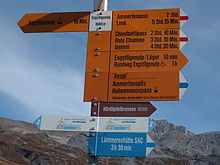Alpine route


An alpine route , also an alpine path , alpine hiking trail , is in difficult, partially pathless terrain.
In contrast to mountain trails, little road construction and maintenance takes place on such routes . Alpine routes are usually neither created nor maintained. Occasionally, safety devices (wire ropes, chains, abseiling points, bolts ) and artificial means of locomotion (pegs, brackets) are attached to particularly difficult places. The usual marking, if any, is blue-white-blue , in Switzerland white-blue-white , in some places there are only cairns or poles as markings. Climbing with a lower level of difficulty ( I, II according to UIAA ) is possible.
The climb requires the mountaineer to be in good physical condition and adequate equipment, surefootedness , sometimes a head for heights , orientation skills and alpine experience or a mountain guide. In addition to weatherproof clothing, rope and ice ax , and possibly even crampons , are sometimes required in the high mountains . Therefore local knowledge or advance information about the route and the conditions is required.
In Switzerland , the alpine hiking trail - as a marked route - is the top and most difficult trail class. The evaluation is based on the SAC hiking scale .
Web links
- Alpine hiking trails
- AV path concept. October 28, 2009, archived from the original on May 26, 2012 ; Retrieved March 30, 2012 .
- Hiking and mountain path concept of the state of Tyrol. (PDF; 4.5 MB) Tyrolean Mountain Path Seal of Approval. Office of the Tyrolean Provincial Government, Sports Department, 2008, accessed on March 30, 2012 .
